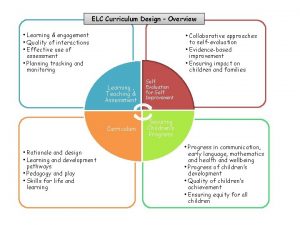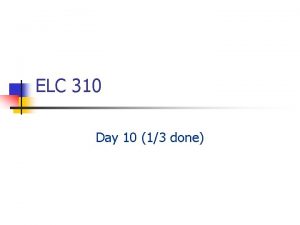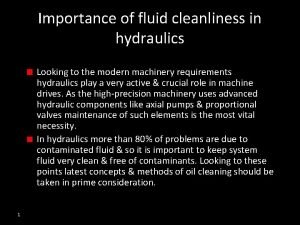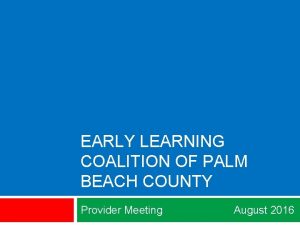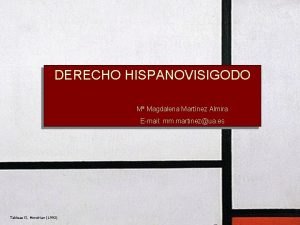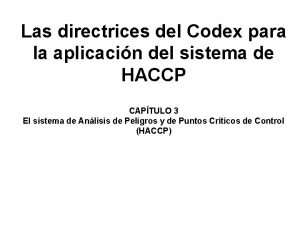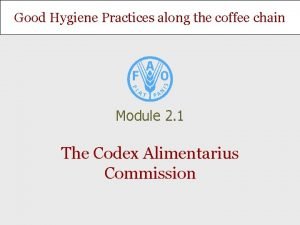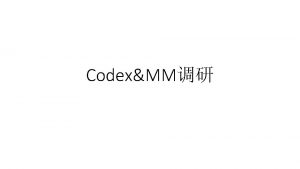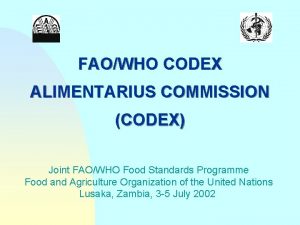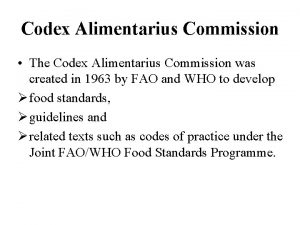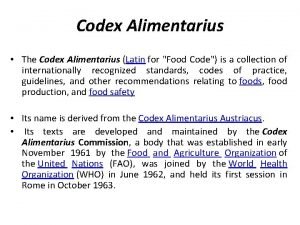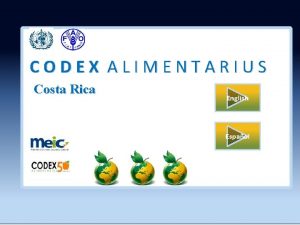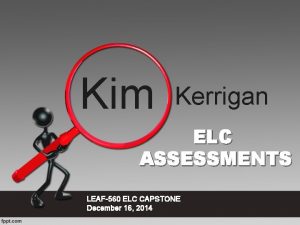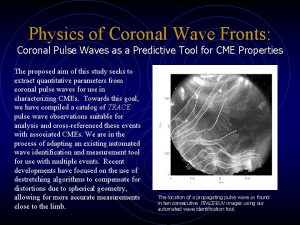ELC 2 COronal Diagnostic EXperiment CODEX ELC 3












- Slides: 12

ELC 2 COronal Diagnostic EXperiment (CODEX) ELC 3 Keel Side ESP-3 ELC 4 ELC 1 Columbus External Payload Facility Jeff Newmark - NASA GSFC Yeon-han Kim - KASI A NASA-KASI Collaborative Project JEM External Facility

C o r o n a l D i a g n o s t i c E x p e r i m e n t ( C O D E X ) CODEXQUAD Quad Chart Objectives What are the sources and acceleration mechanisms of the solar wind? • Are there signatures of hot plasma released into the solar wind from previously closed fields? • What are the velocities and temperatures of the density substructures that are observed so ubiquitously in streamers and coronal holes? Complementary Observations: • Significant enhancement to Parker Solar Probe, Solar Orbiter, and Do. D Ultra. Violet Spectro-Coronagraph • Space Weather Applications – CMEs Key Team Organizations • NASA GSFC/GB: PI Institute, PI = J. Newmark, GSFC/GB Team. Coronagraph, Science, SE, SM&E, Environmental, etc. • NASA GSFC/WFF: PM = L. Thompson, and GSFC/WFF INSPIRE engineering team. Payload SE, pointing, power, mechanical, etc. • KASI (Korea): Major partner, Y. -H. Kim, K. -S. Cho and KASI team. Filter wheel, Camera/detector, C&DH computer and FSW. • NRL: Science, Calibration: L. Strachan • INAF (Italy): Science: S. Fineschi Guidelines and Status Schedule Milestones (DRAFT) Internal SRR Dec. 2019 • A NPR 7120. 8 Tailored project following GPR 8705. 4 Internal KASI PDR Feb. 2020 • Kickoff Meeting: October 16, 2019 CODEX PDR May 2020 Safety Review #0/1 Jun. 2020 Internal KASI CDR Nov. 2020 • Draft Schedule in place, started working details CODEX CDR Dec. 2021 Safety Review #2 Jan. 2021 • Resources are in place with a couple exceptions. Pre-Environmental Review Aug. 2022 • Trade Studies identified and being worked Safety Review #3 Nov. 2022 • Documentation has started with some out for review. Pre-ship Review Dec. 2022 FRR/MRR Jan. 2023 Launch Feb. 2023 Sensitive – May Contain Proprietary Data • Funding in place CODEX NASA-KASI WG Page 2

C o r o n a l D i a g n o s t i c E x p e r i m e n t ( C O D E X ) Roles and Responsibilities 3 GSFC Greenbelt • • • GSFC Wallops Flight Facility • • • Naval Research Laboratory Korea Astronomy and Space Science Institute (Contributions) Istituto Nazionale Di Astrofisica (INAF) Sensitive – May Contain Proprietary Data PI, Co-Is Coronagraph Science Operations and Data Center, Data Analysis Project Systems Engineering, S&MA, Environmental Testing, AI&T Thermal PM/DPM Payload Systems Engineering, S&MA Pointing System, AI&T Mechanical Structure/Mechanism Power Distribution • Co-I • Instrument Calibration • Co-Is • Command Data Handling Computer (purchase GSFC hardware), flight and ground software • Detector and readout electronics • Filter Wheel Assembly • Science Center and data analysis • Collaborator - science CODEX NASA-KASI WG Page 3

Science Motivation C o r o n a l D i a g n o s t i c Abbo et al. 2015 Temperature (MK) E x p e r i m e n t ( C O D E X ) CODEX • A crucial gap in the information on the physical conditions in the solar wind acceleration region (3 -9 R☉) • The gap is between the spectroscopic measurements (<3 R☉) and the Parker Solar Probe measurements (>9 R☉) • An electron temperature variation (blue curve) is assumed by solar wind models to obtain the speed (red curve) • This new capability of combining simultaneous electron density, temperature, and velocity will be the first time all three have ever been measured simultaneously for this FOV, and we will do it globally, nearly daily for 6 months! This is a comprehensive dataset to test all models of solar wind acceleration and source and will be a regular, systematic, comprehensive validation of space-weather/operational models in the crucial source region of the solar wind. • CODEX will provide information on physical conditions in the coronal region not reachable by Parker Solar Probe. Sensitive – May Contain Proprietary Data CODEX NASA-KASI WG Page 4

5 CODEX Will Provide Breakthrough Science Capability C o r o n a l D i a g n o s t i c E x p e r i m e n t ( C O D E X ) • Currently white light coronagraph images provide electron density • CODEX will use spectral information to also determine temperature and flow velocity. Allows fast and slow solar wind models to be tested. • Enhances Parker Solar Probe and Solar Orbiter science • Provides Space Weather relevant data – Coronal Mass Ejections (CMEs) Density Velocity • A crucial gap in the information on the physical conditions in the solar wind acceleration region (~3 -10 R☉) • This new capability of combining simultaneous electron density, temperature, and velocity will be the first time all three have ever been measured simultaneously for this FOV, and we will do it globally, nearly daily for 6 months! Sensitive – May Contain Proprietary Data Temperatur e CODEX NASA-KASI WG Page 5

C o r o n a l D i a g n o s t i c E x p e r i m e n t ( C O D E X ) Knowledge of the Solar Wind, Fundamental to All of Heliophysics…Provided by CODEX Current State-of-the-Art Surface magnetograms input into a model, results are then used in an empirical correlation to estimate the solar wind speed near the Sun CODEX will provide solar wind speed data for input into models like ENLIL Lo-Res LOS Magnetogram for last full rotation Sensitive – May Contain Proprietary Data Potential Field Source Surface Model In addition, very few observations of the solar wind outside of Earth orbital plane exist. CODEX will observe high latitude solar wind every day Wang, Sheely, Arge Model At source surface ENLIL Solar Wind Model CODEX NASA-KASI WG Page 6

C o r o n a l D i a g n o s t i c E x p e r i m e n t ( C O D E X ) Science Traceability Matrix Science Objectives Science Goal Scientific Measurement Requirements Physical Observables Parameters Instrument Requirements A time series of images showing the motion and evolution of Field of View (FOV) electron density structures in the solar wind in total brightness (density), temperature, and Are the acceleration Observe the radial velocity structures from the tops Image Cadence profiles different on temperature and of streamers out near the sonic the sub-structure velocity profile of the point within streamers or solar wind at a range A time series of images showing coronal holes? of latitudes the evolution of fine scale electron density, temperature, What are the sources and velocity structures in coronal Spatial Resolution acceleration mechanisms of holes from near the surface to the solar wind? near the sonic point Observe the evolution of fine Is there evidence for scale electron A time series of total brightness magnetic field density structures images showing the evolution of Stray light interchange showing the fine scale electron density reconnection evolution of outward structures in coronal holes from contributing plasma moving features near the surface to near the from previously (blobs) from near the sonic point closed fields to the closed field solar wind? boundaries and streamer stalks Spectral Bandpass Enable and validate the next generation of space weather science models How accurate are present models at predicting the global coronal structure? Observe the evolution of electron density structures to track the daily evolution of the global corona An overlapping series of total brightness images showing global structure of coronal density features of the K-corona Observe the global radial temperature and velocity profile of the solar wind A time series of images showing Signal-to-Noise Ratio (SNR) coronal features in total brightness (density), temperature, and velocity of the K-corona to trace magnetic field lines Sensitive – May Contain Proprietary Data 3 -12 R☉ 2 orbits = 3 hours for all measurements using 4 band pass filters 30 arcsec for density 4 arcmin for temperature 4 x 10 arcmin (long direction is radial) for velocity < 1% of local corona for 3 < r < 12 R☉ 5 nm band pass filter @ 393. 5, 405. 0, 398. 7 and 423. 4 nm, plus broadband 380 -430 > 200 (for co-added exposures) CODEX NASA-KASI WG Page 7

C o r o n a l D i a g n o s t i c E x p e r i m e n t ( C O D E X ) Why Have a Coronagraph on ISS? • Ground testing and the upcoming balloon flight, have proceeded as far as possible, the next step to utilizing this new coronagraph tool is to fly in space. • ISS is a cost effective platform to demonstrate the new instrument technology and scientific utility of the new diagnostic coronagraph. - Demonstrates the ability to meet future space weather observing needs. • Flying CODEX on ISS serves as a pathfinder for a improved instrument to fly on the Lunar Orbiter Platform – Gateway (LOP-G). This upcoming platform provides extended solar viewing an ideal location for performing continued science and long-term space weather requirements. Sensitive – May Contain Proprietary Data A coronagraph onboard SKYLAB provided some of the earliest images of solar Coronal Mass Ejections (CMEs) CODEX NASA-KASI WG Page 8

C o r o n a l D i a g n o s t i c E x p e r i m e n t ( C O D E X ) Why Now? Societal Benefits • CODEX serves a NASA, national (and international) need to replace aging coronagraphs which provide data in support of space weather modeling used by NASA, NOAA, European Space Agency-Space Situational Awareness and others. - NOAA Space-Weather-Follow-On may not launch until 2024 or later! - A successful mission now demonstrates the technology and providing key science and space weather relevant data while this key asset is readily available! • CODEX will provide observations that support the long term forecasts of CME arrival by understanding the background solar wind and directly imaging CMEs. • New data products from CODEX - Will stimulate advances in scientific modeling capabilities to improve modeling of the heliosphere. - Will provide data to continue the development of National and International models in the event of a failure of the SOHO (launched 1995) or STEREO (launched 2006, only 1 currently functioning) coronagraphs (only 2 current coronagraphs in space). • The improved models will provide the scientific basis to support future space travel to the Moon, Mars, and other destinations in the Solar System. • Next Generation of Coronagraphs called out in the National Space Weather Strategy and Action Plan! Sensitive – May Contain Proprietary Data CODEX NASA-KASI WG Page 9

C o r o n a l D i a g n o s t i c E x p e r i m e n t ( C O D E X ) CODEX EVR Microfixtures Gimbal Coronagraph Motor Driver IMU HFSS Space. Cube Mini processors Power Distribution unit FRAM (ISS RIO Provided) Sensitive – May Contain Proprietary Data Star Tracker CODEX NASA-KASI WG Page 10

CODEX Coronagraph ( C O D E X ) Optics Camera E x p e r i m e n t Aperture Door C o r o n a l D i a g n o s t i c Baffles Heat Rejection Mirror Sensitive – May Contain Proprietary Data Light Path External Occulter CODEX NASA-KASI WG Page 11

C o r o n a l D i a g n o s t i c E x p e r i m e n t ( C O D E X ) What Aspect of the CODEX Mission Will Most Engage the General Public ? • The anticipated CODEX discoveries will underscore the value of the ISS for accommodating instruments capable of achieving breakthrough science. • We learned from SDO/STEREO/SOHO that there is significant public interest in how observations are used to answer long -standing questions about how the Sun affects the rest of the solar system. • The public should be interested in CODEX’s discoveries that lay the groundwork for understanding our space environment, improving our ability to forecast space weather, and fostering the commercialization of space. • The key to predicting space weather is to understand the underlying physical processes that control it. Source: ESA CODEX will achieve breakthrough science, operationally relevant data, and fascinate the public! Sensitive – May Contain Proprietary Data CODEX NASA-KASI WG Page 12

